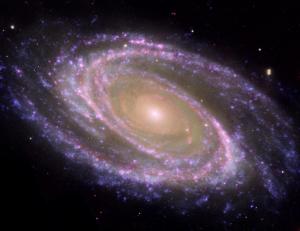How do we know…? Where we are in the Galaxy
Posted: September 15, 2010 Filed under: How do we know....? | Tags: Galaxy, Milky way 6 Comments
If we could take a picture of the Milky Way like this knowing where we are in the Galaxy would be easy.
Well it’s easy isn’t it, we just go outside the Galaxy, take a picture looking back and see where the Sun sits and what the Galaxy looks like. If only it were that simple. The problem with figuring out our place in the Galaxy is that we are sitting inside it. This means we have to work harder to determine the fine details of the structure of the Galaxy.
The faint fuzzy band that snakes its way across the sky has been identified since ancient times. Both its modern colloquial and scientific name derive from Greek mythology. The “Galaxias” was the milk spilled by Zeus’ sister Hera while feeding Heracles (the hero, not the football team from Twente). By the 11th century the Persian astronomer Abu Rayhan Biruni had theorised that the winding smudge was itself made of countless unresolved stars. This theory would have to wait 600 years for Galileo’s first telescopic observations to be proved correct.
But what shape did this huge mass of stars take and where did we lie within it? Kant and Wright theorised that the Milky Way was a flat disk of stars which rotated due to gravitational forces. The Herschel siblings tried to map out the galaxy by counting the number of stars in different directions. This lead them to the conclusion that the Sun was fairly near the centre of the Milky Way. But there was a problem with their work, something they hadn’t considered.
The space between the stars is pretty empty, but it is not a total void. There are small amounts of gas and dust which, when added up over the huge distances light has to travel to get to us, can block out a fair amount of star light. This gas and dust congregates near the plane of the Milky Way meaning stars within the disk at great distances from the Earth are almost totally obscured.
Imagine you are in a big city on a clear day, looking about you’ll be able to see a collection of tall buildings in the city centre. In the other direction the buildings get more sparse towards suburbia. Now picture the same scene in fog. Perhaps you’ll be able to pick out the vague outline of a few skyscrapers, perhaps not. You might only be able to see the buildings around you. This is what interstellar gas and dust does to the study of Galactic structure.
A huge breakthrough in determining our location in the Milky Way came in the early 20th century when Harlow Shapley used a class of variable stars known as Cepheid Variables to measure the distance to compact groups of stars known as Globular Clusters. He found that the Globular Clusters formed a cloud centred a long way from the Sun. Instead of being in the centre of the Galaxy we were moved to the quiet suburbs.
Now with the great expansion of astronomy across the full spectrum of available light (not just visible) we have so much more data with which to study our Galaxy. Radio observations allow us to see how the gas in the Galaxy rotates around the centre, infrared observations show a small galaxy being ripped apart on the other side of the Galactic disk, while we can see stars zipping round the huge black hole in the centre of the Galaxy . These stars allow us to measure the distance to the centre of the Galaxy. One study traced out the orbit of one star and also measured its line of sight velocity relative to the Earth. This allowed them to measure the mass of the black hole at the centre of the Galaxy and also our distance from it. This showed we are 26,000 light years from the centre of the Galaxy, in a fairly nondescript suburb of the Milky Way.
Ghez, A., Salim, S., Weinberg, N., Lu, J., Do, T., Dunn, J., Matthews, K., Morris, M., Yelda, S., Becklin, E., Kremenek, T., Milosavljevic, M., & Naiman, J. (2008). Measuring Distance and Properties of the Milky Way’s Central Supermassive Black Hole with Stellar Orbits The Astrophysical Journal, 689 (2), 1044-1062 DOI: 10.1086/592738


The title of this post is a question. Is the name of this blog the answer?
Ha, yes hadn’t noticed the page title until you pointed it out.
[…] How do we know…? Where we are in the Galaxy […]
I noticed when I used bit.ly to shorten the URL for Twitter: it placed the blog-name right after the post title 😉
[…] are all in the gutter: How do we know…? Where we are in the Galaxy We are all in the gutter: How do we know…? How old the universe is? We are all in the gutter: A […]
I HATE ASTRONOMY !!!!! THIS CLASS HAS CAUSED ME WRINKLES; QUICKER THAN FUCKING GRAVITY EVER WOULD HAVE!!!!!!!!!!!!!!!!!!!!!!!!!!!!!!!!!!!!!!!!!!!!!!!!!!!!!!!!!!!!!!!!!!!!!!!!!! AHHHHHHHHHHHHHHHHHHHHHHHHHHHHHHHHHHHHHHHHHHHHHHHHHHHHHHHHHHHHHHHHHHHHHHHHHHHHHHHHHHHHHHHHHHHHHHHHHHHHHHHHHHHHHHHHHHHHHHHHHHHHHHHHHHHHHHHHHHHHHHHHHHHHHHHHHHHHHHHHHHHHHHHHHHHHHHHHHHHHHHH